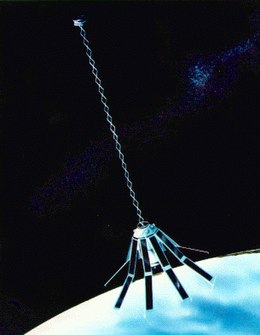Geosat

Artist's interpretation of the Geosat satellite
|
|
| Mission type | Earth science |
|---|---|
| Operator | United States Navy |
| COSPAR ID | 1985-021A |
| SATCAT no. | 15595 |
| Mission duration | 5 Years |
| Spacecraft properties | |
| Dry mass | 635.0 kilograms (1,399.9 lb) |
| Start of mission | |
| Launch date | March 13, 1985, 02:00 UTC |
| Rocket | Atlas E/F OIS |
| Launch site | Vandenberg SLC-3W |
| Orbital parameters | |
| Reference system | Geocentric |
| Regime | LEO |
| Semi-major axis | 7,146.2 kilometres (4,440.4 mi)> |
| Eccentricity | 0.00398 |
| Perigee | 757 kilometres (470 mi) |
| Apogee | 814 kilometres (506 mi) |
| Inclination | 108.0596 degrees |
| Period | 100.6 minutes |
| RAAN | 309.0682 degrees |
| Argument of perigee | 276.8275 degrees |
| Mean anomaly | 131.8715 degrees |
| Mean motion | 14.37442186 |
| Epoch | 09th December 2013 |
| Revolution no. | 50565 |
The GEOSAT (GEOdetic SATellite) was a U.S. Navy Earth observation satellite, launched on March 12, 1985 into an 800 km, 108° inclination orbit, with a nodal period of about 6040 seconds. The satellite carried a radar altimeter capable of measuring the distance from the satellite to sea surface with a relative precision of about 5 cm. The initial phase was an 18-month classified Geodetic Mission (GM) have a ground-track with a near-23-day repeat with closure to within 50 kilometers. The effect of atmospheric drag was such that by fail 1986 GEOSAT was in an almost exact 23-day repeat orbit.
After the GM concluded 30 September 1986, GEOSAT's scientific Exact Repeat Mission (ERM) began on November 8, 1986 after being maneuvered into a 17.05 day, 244 pass exact repeat orbit that was more favorable for oceanographic applications. When the ERM ended in January 1990, due to failure of the two on-board tape recorders, more than three years of ERM data were collected and made available to the scientific community.
The Geosat GM goal was to provide information on the marine gravity field. If the ocean surface were at rest, and to forcing such as tides or winds were acting on it, the water surface would lie along the geoid. To first order, the Earth shape is an oblate spheroid. Subsurface features such as seamounts create a gravitational pull, and features such as ocean trenches create lower gravity areas. Spatial variations in gravity exert influence on the ocean surface and thereby cause spatial structure in the geoid. The deviations of the geoid from the first order spheroid are on the order of ± 100m. By measuring the position of the water surface above the Earth center, the geoid is observed, and the gravity field can be computed through inverse calculations.
The U.S. Navy declassified parts of the Geodetic Mission data in 1990 that covered a doughnut-shaped area of ocean that surrounds Antarctica between 60 and 72 degrees south latitude. In 1992, further parts of the Geodetic Mission data over the oceans south of 30 degrees south were released. The GEOSAT data for the entire global sea surface was declassified in July 1995 after the competition of the geodetic phase of ESA ERS-1 mission. These data were subsequently widely used to estimate ocean bathymetry along with additional satellite altimeters.
...
Wikipedia
